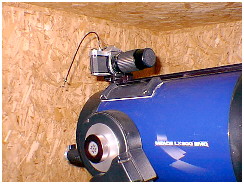Some of the most popular 35mm cameras used for astrophotography are the: Nikon F3, Pentax LX, Pentax K1000, Olympus OM-4T, KR-5 Super, Nikon IIF,F2, and the Olympus OM-1. See Astronomy Magazine March 1996 "How To Choose the Right Astro-Camera".
The fully electronic camera is very popular with the non-astronomy related photographers who trade in their old manual cameras. Most camera dealers have the old style manual cameras in stock and very cheap...exactly what you want!
There are four basic configurations of mounting a camera for astrophotography and obtaining good results: tripod (easiest), piggyback(easy), prime focus (harder), and eyepiece projection (hardest).
Tripod
 For the beginner, the easiest way to photograph star patterns, moonscapes, comets, and bright celestial objects is to mount the camera on a tripod. Attach a locking cable release to the shutter release button and shoot. A locking cable release decreases the amount of vibration in opening the shutter, compared to opening it with your finger possibly shaking the camera. A trail of stars around Polaris, the north star, is a good starting point. Set the lens to full open and expose for 20 minutes. Constellations and star patterns are also favorite targets.
For the beginner, the easiest way to photograph star patterns, moonscapes, comets, and bright celestial objects is to mount the camera on a tripod. Attach a locking cable release to the shutter release button and shoot. A locking cable release decreases the amount of vibration in opening the shutter, compared to opening it with your finger possibly shaking the camera. A trail of stars around Polaris, the north star, is a good starting point. Set the lens to full open and expose for 20 minutes. Constellations and star patterns are also favorite targets.
Piggyback
 Placing the camera on top of a telescope, thus utilizing its tracking feature, is called "piggyback" astrophotography. This method allows a longer exposure so as not to produce star trails due to the earths movement. With a telescope that is polar aligned, point the telescope with the camera attached to it , open the lens to f/4 - f/2 and open the shutter. Depending on the lens, exposures of up to 4-5 minutes are possible without star trails; longer exposure times may require minor guiding.
Placing the camera on top of a telescope, thus utilizing its tracking feature, is called "piggyback" astrophotography. This method allows a longer exposure so as not to produce star trails due to the earths movement. With a telescope that is polar aligned, point the telescope with the camera attached to it , open the lens to f/4 - f/2 and open the shutter. Depending on the lens, exposures of up to 4-5 minutes are possible without star trails; longer exposure times may require minor guiding.
Prime Focus

 Prime focus photography consists of attaching the camera to the telescope utilizing the telescope as a giant lens. The camera is attached to the telescope with a T-ring (to fit your specific camera)and a T-ring adapter (see image). This type of configuration requires guiding the telescope either manually using the hand controls or with an electronic guider for longer deep space exposures, however, it is possible to do lunar and planetary photography with little or no guiding.
Prime focus photography consists of attaching the camera to the telescope utilizing the telescope as a giant lens. The camera is attached to the telescope with a T-ring (to fit your specific camera)and a T-ring adapter (see image). This type of configuration requires guiding the telescope either manually using the hand controls or with an electronic guider for longer deep space exposures, however, it is possible to do lunar and planetary photography with little or no guiding.
Eyepiece Projection
This method utilizes a different type of an adapter, called a tele-extender. A tele-extender is an eyepiece projection tube for high magnification photography of the moon and planets. It is attached over the visual back, with eyepiece installed; the eyepiece magnifies the images by projecting it onto the film.